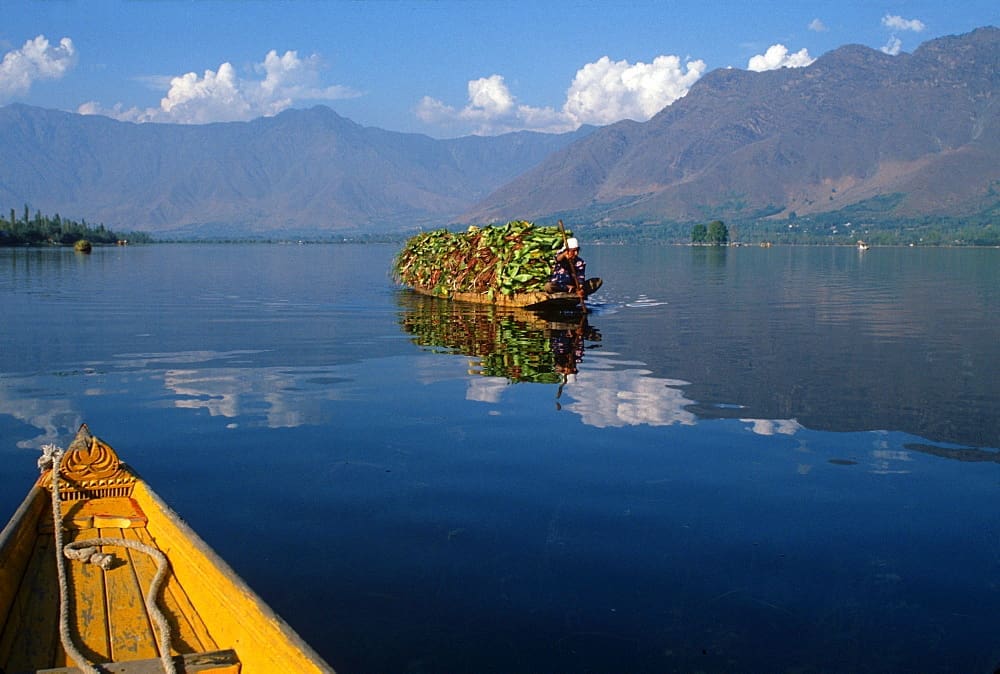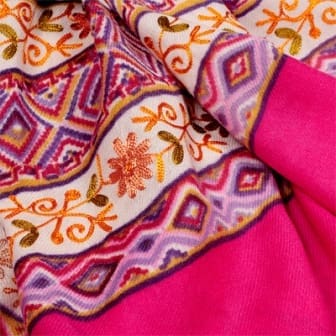
“The heaven on Earth”, a title which the northern most state of India has been relishing in for years and every ounce of air in Kashmir make a great case for it. Already endowed with a spectacle of natural beauty in all its magnificence, the people of Kashmir carry with them a tradition so beautiful and rich, that it has mesmerised the entire world.
The textile tradition in Kashmir has a glorious history of world renowned tapestry that is popular among many. May it be the Kani shawls or the Amlikar needle work, even today the hand-woven textile products are a speciality of the many Kashmiri skilled weavers.
A little history first
In Kashmir, the earliest records of tapestry designs go back as far as the seventh century. In the sixteenth century Mughal period, however there was a boom in the popularity of Kashmiri shawls in the country. Primarily worn by Kings and royal courtiers, the uniquely gifted work of many weavers found its ways beyond South Asia in this period. It was only in mid-1800s, the Kashmiri shawls became popular among the European elite mainly the French. In the late eighteenth century, the industrial age appeared, which bestowed a certain global acknowledgement to this ancient art-form.
The fabric behind a great shawl
The shawls which are known for its in imitable tapestry design make use of a fibre commonly known among the natives as Pashm or Pashmina. The fibre normally comes from the fleece of a wild Cashmere Asian mountain goat known by its scientific name as Capra hircus.
The goat sheds its wool in the early days of June as the summer approaches, which gets stuck in the bushes and shrubs around the region. Shawl-maker usually gather this wool which is characterised by its exclusive properties, to make a good Pashmina shawl. The fibre is only 15 micron in thickness along with being extremely regular in structure, making it a perfect fibre for ‘fine spinning’. Although there are many other source of fibre that are mixed to augment the quantity of the raw material, the Pashmina shawls remains unique for being soft, silky and warmer than others.
Kani Shawls or Jamawar
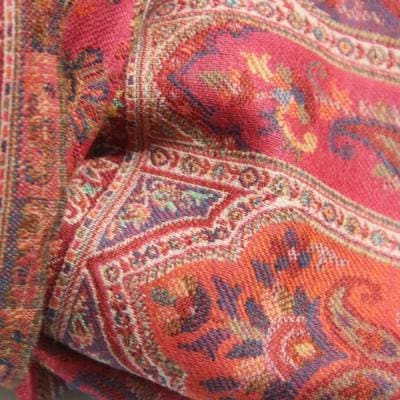
The beautiful tapestry among the Kashmiri textile is more evident in its most popular version. The Kani shawls are made from special ‘Kani needle’ as each shawl take around a year of two to be done by the traditional method. This is a tradition that was revived in the post-independence India, which is identified with its characteristic intricately woven designs. These pashmina figure-shawls are composed of discontinuous coloured weft interlocked within each other. These gorgeous looking shawls are entirely made of wool, however in some instance a little cotton is added. The motifs are beautiful imitation of nature displaying flowering plants with vivid colours.
Amlikar shawl
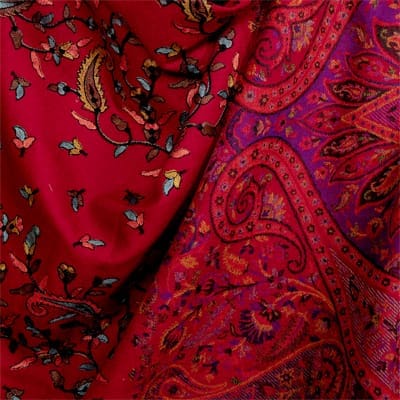
The Amlikar or Amil needle work is another speciality of Kashmiri artwork, as these shawls are filled with rich colours with beautiful motifs of flowers. Made entirely with the Pashmina wool, the needle work is only one to have an embroidery stitch paralleltothe darning stitch, made possible by some of the divinely skilled rafoogars (darners). These are so delicately woven that the needle neverreally penetrate the entire fabric during the entire making of a shawl.
Dourukha shawls

This is a type of woven shawl which you should look out for. With its multi coloured pattern, the dark coloured outlines highlight its contrast with the rest of the shawl. But the thing that make it more unique is that the artisan achieves the same effect on the both sides of the shawl.
Kashmiri shawl motifs
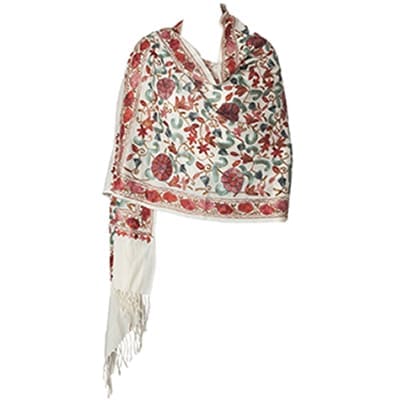
From early simple designs to the intricate motifs that are seen today, Kashmiri shawls display an ancient art of fascinating nature. There are few basic characteristics you can identify with the Kashmiri embroidery. The formative imitation of natural beauty that a Kashmiri motif may display includes depiction of flowers, leaves enriched with diverse colours, such as yellow, white, black, blue, green, purple, crimson and scarlet.
Brilliantly crafted embroidery flows smoothly with the surface of a shawl and the rich colours together become an integral part of the entire fabric. The contrast among different part of a shawl mainly the gallery and field is what draw our eyes in.
The artisans
The skill and the mastery of art has run through countless generations among the shawl-makers. Primarily it were the women folk who used to carry out every part of shawl-making process. From cleaning of raw fleece to the entire needle work. Many of them have able to pass down some amazing talent to their children and the art has survived through years mainly through safe-keeping by the new generation.
In its early time, the amazing skills for shawl maker were largely unrewarded as weavers were left counting the pennies, as the middlemen used to make a fortune n he market abroad. These days, the art is more commercialised and though it has brought sufficient appreciation to the real skill, dilution in the quality of work has occurred. Many weaver still prefer hand-woven style of shawl making as finding the quality wool is also imperative.
However the customer these days has grown more vigilant as demand for a quality level Kashmiri shawl is relentless.
Among the various crafts, Pashmina weaving remained key economic activity in the Kashmir valley for centuries. Besides employing literate as well as illiterate persons in both rural and urban areas, it acts as a subsidiary source of income for farmers who remain unemployed during the off-season. But unfortunately today the craft of making pure and authentic Pashmina is vanishing thanks to the introduction of power loom.
What is real Pashmina?

Pashmina shawls and stoles. Image Credit: Qazi Wasif
There are also several misunderstandings around Pashmina. For one thing, it starts with the word ‘Pashmina’ itself. It is locally known as Pashmina, while in Europe and other countries it is known as Cashmere. Both mean the same thing. Also, it does not come from a sheep’s skin or other such things. It comes from the naturally shedding hair of a particular goat found in Ladakh.
According to experts, the raw material of genuine Pashmina should be obtained under the fleece of mountainous goat called Capra Hircus, which is collected by combing, since the goat sheds its winter coat naturally.
The most important aspect is that it should be hand spun and hand woven only.
Once the raw material is acquired from Ladakh, all the process should be done manually by workers, right from spinning to weaving on handlooms.
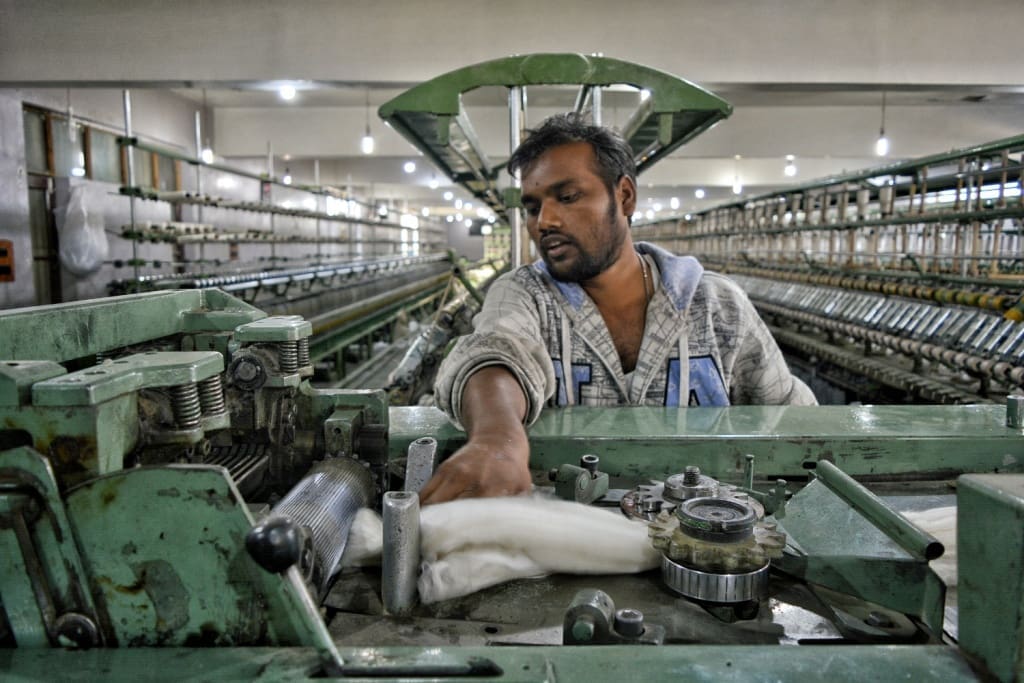
The De-haring process. Raw material is brought either from Ladakh or China and fine hairs of Pashmina are separated. Image Credit: Qazi Wasif
However, this trend is changing as there is a lot of competition in the international market and the demand for the fabric is ever growing all around the world. Therefore more and more people are changing to power looms as it is much cheaper and its production capacity is more than that of a traditional handloom.
“Power looms can produce 15 shawls per day while a handloom can barely produce two shawls per day. It also reduces manpower, hence the number of handlooms in the valley is on the decline,” said Izhan Ahmad, a manufacturer of Pashmina shawls.
However, while looms have increased the production capacity, at the same time there are fears that the move has compromised the quality of ‘real Pashmina’. Also, the power looms have put a large number of people out of a job. A section of Pashmina weavers in the valley currently demand a ban on the use of power looms.
Why have power looms compromised the quality of real Pashmina?

A man keeps a vigil on spinning machine, to check if there are any flaws. Image Credit: Qazi Wasif
Ayesha, 70, a Pashmina user for decades says, “We used to pass it from one generation to another. But today if you use a Pashmina shawl several times, it loses its charm. That durability is gone, it’s no more.”
Promotion
While that is an anecdote and personal experience, there are scientific reasons for this drop in quality as well. The raw material used for Pashmina making is called ‘Taar’ in the local language. This is basically the hair of the goat and is very soft.
Its fragility makes it suitable for traditional looms only. Taar cannot withstand the brute force of a power loom. Therefore, to strengthen it, nylon and other synthetic fibres are added during the spinning process.
This is where the ‘adulteration’ happens and where ‘real Pashmina’ is spun into ‘fake Pashmina’.

After fixing the number of counts, the Pashmina is finally ready to be placed on looms for weaving. Image Credit: Qazi Wasif
However, power loom users argue that once the fabric is prepared, it is washed with certain acids, which melt away the nylon. They state that it regains its old charm and becomes 100 per cent Pashmina again.
But even here, experts disagree, since they say real Pashmina loses its quality after the acidic washing. “It’s like the first copy of something which we buy from the market, almost similar to the real one. We are not able to differentiate between the two,” said Izhan.
Why is Kashmiri Pashmina the best in the world?

Then this thread is placed on the loom for final processing which is weaving. Image Credit: Qazi Wasif
Pashmina is produced by many countries in the world. China is the largest producer by volume. But it does not produce the best quality of Pashmina. This is because the micron count (fineness of the hair) of Ladakhi Pashmina is 14 while that of China is 16.
Moreover, the concept of handloom is not common in China while artisans in the valley have been using handloom right from the beginning of Pashmina weaving, which goes back to centuries.
It also depends upon the count of the fabric. This the number of yarn threads that are used to make a shawl. More the number, the softer the fabric. The average count on which Pashmina is made in the valley is around 160 counts. The minimum is 30. It is an inverse relationship. The fewer the number of microns and more the number of counts, the better the Pashmina.
Arts and Craft of Jammu and Kashmir
The splendid Handicrafts of Jammu and Kashmir make it famous all over the world. Some kind of elegant art work is present almost in everything in Jammu and Kashmir, be it embroidery on the shawls, papier-mache and steel ware and wood work. When it comes to Jammu and Kashmir Handicrafts, the villages of Anantnag and Srinagar have been quite famous for enhancing its creative beauty. They are world famous for carpets and wooden furniture. Along with it, the antique items include Shahtoosh Shawls and Pashmina shawls. Crewel ware, brass and silver ware are other interesting articles.
Famous Art and Crafts of Jammu and Kashmir:
Carpets

Definitely, one of the most expensive and world renowned arts of Kashmir. Originally, the art of making carpets started from Samarkand in Central Asia. Later, the process itself witnessed a tremendous growth with the artisans from Iran experimenting with the motifs and textures. Carpets from Kashmir are made of wool and even silk, are available in a large number of variety.
Basket Weaving

These are made of willow rushes and this form of weaving can be used to make baskets or even lamp-shades. A little expensive, they can also be used as glass holders or picnic baskets. Hazratbal in Srinagar is known for basket weaving throughout India.
Embroidery
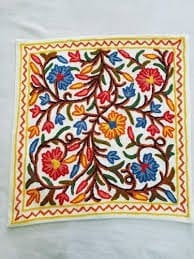
The typical Kashmiri embroidery is known as Kasida and is famous all over the world. It is very exquisite in its execution and is very rich and elaborate in colour. Quite interestingly, this embroidery, which is often done on saris and shawls, does not have a wrong side to it.
Papier Mache
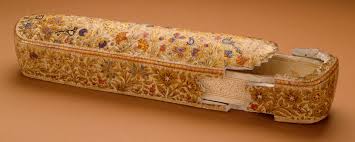
No matter how similar the papier mache articles look at the first glance, they have their own differences and originality. Three grades of paper are used for its designing. In the process of making it, paper is soaked in water till the time it disintegrates. Then an adhesive solution is used to mix it over, eventually molding it into different shapes which are later coloured and varnished.
Tweed

Tweed is a pure wool product that goes through eight steps of wool shearing to take various shapes. Products of Tweed are available as long winter coats, jackets, blazers, waistcoats, suits, trousers, caps; also wedding suits. Apart from providing good insulation during winters, it is also a flourishing form of art and craft in Kashmir.
Walnut Wood Products
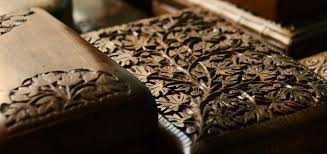
Kashmir is home to the best of walnut trees in the world. The wood of these trees are used to create various furniture and showpiece items. Kashmir has talented artists whose wood works have taken the products to international level. The state is known for semi carvings, lattice work, lotus flowers and chinar motifs. While on a shopping spree, products to pick up are furniture (tables, chairs, writing desks, dining tables etc.), cigar and cigarette boxes, jewelry boxes, photo frames and countless other articles.
Costumes of Jammu and Kashmir
They are well known for their embroidery and intricate designs, which reflects the richness of the culture and landscape of the region. The form of clothing is designed to counter the cold climate of the region. Most of the garments are made of wool, silk designed with intricate embroideries and cotton.

The traditionally Poots & Pheran is the most popular form of dress among both men and women With Mughal type Turbans, headgear, Taranga Belt of Pashmina and colored scarf.
Costumes of
Kashmiri Women
The Pheran is the prominent attire for Kashmiri women. The Pheran worn by women
usually has Zari, embroidery on the hem line, around pockets and mostly on the
collar area. Ladies prefer suit and Burgha in summer and Pheran are preferred
in autumn.
For Hindu Women
Pheran
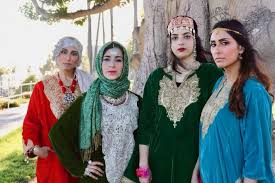
The Hindus women of Kashmir wear their Pherans long, stretching up to their
feet with narrow sleeves cloths which is turned on the bottom side. Often, the
Pherans are wrapped tightly on waist by a piece of creased cloth called Lungi.
The Hindu women, started wearing the saree now But as per the culture of the
Kashmir region, they have to wear taranga on their marriage day.
Headdress – Taranga

The headdress of a Kashmiri woman is a brightly colored scarf or Taranga, that
is stitched to a suspended cap and it narrows down at the back, towards the
heels. The Taranga is an integral part of the wedding attire among Hindus.
Jewelry
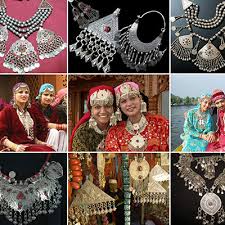
Earrings, anklets and bangles are widely used
apart from the use of ornamentation in clothing. Dejharoos or golden pendants
(the Kashmiri panditani’s mangal-sutra) are worn by the Hindu women. These
Dejharoos comprise two decorative gold pendants which are suspended through
gold chains or silk threads. It is symbolic of a woman’s married status among
the Kashmiri Pandits.
.
Costumes of Kashmiri Men
Kashmiri – Men Pheran

The typical dress of a Kashmiris man both Hindu and Muslim is Pheran, a long
loose gown hanging down below the knees. The men wear a skullcap, a
close-fitting shalwar (Muslims) or churidar pyjama (Pandits).
The traditional Hindu male garment pheran is always plain and has narrow
sleeves and a left side breast-open collar with a kind of lapel or lace
emerging from it.

Kashmiri Clothing Style
The Pheran is a loosely fitted woollen garment which makes use of the Kangri. The Kangri is an earthen vessel which is filled with flaming coal. The Pathani Suit, also referred to as Khan-dress, is popular among the Muslim men, especially in Srinagar.
Turbans for Muslim Male

Turbans are common among Muslim men. Skull caps are prevalent, especially among
the peasants and the Karakuli. Fur skull caps with the Pashmina shawls worn by
men often symbolize royal lineage. The Muslim men wear lace-free shoes known as
Gurgabis.
Major Tribes in Jammu and Kashmir
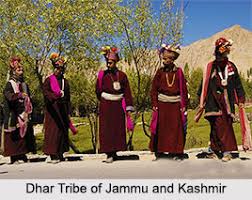


There are twelve major tribes in Jammu and Kashmir. These tribes are: 1) Balti 2) Beda3) Bot, Boto 4) Brokpa, Drokpa, Dard, Shin 5) Changpa 6) Garra 7) Mon 8) Purigpa 9)Gujjar 10) Bakarwal 11) Gaddi 12) Sippi.2 These twelve tribes were granted theScheduled Tribes status under the Article 342 of the Constitution of India and Section 50,sub section 6 of the Constitution of Jammu and Kashmir in two phases. In the first phasethrough the Constitution (Jammu & Kashmir) Scheduled Tribes Order, 1989 that wasissued on 7th of October 1989, eight communities in the state were declared as the;Garra; Mon and Purigpa. In the second phase through the Constitution (ScheduledTribes) Order (Amendment) Act, 1991 that was issued on 20th August 1991, four othercommunities were granted the Scheduled Tribes namely; Bakarwal, Gujjar, Gaddi andSippi.
offical tourism: https://www.kashmir-tourism.org/
This article was written by Bhavika Gulrajani B.Sc in Textile and Apparel Design from Sir Vithaldas Thackersey College Of Home Science. Textile Value Chain intern

